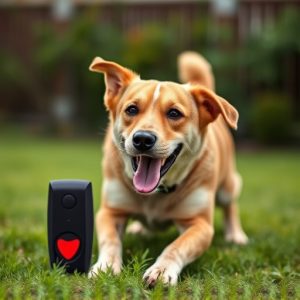Dog Repeller EMC Certification: Effective Frequency Range for Deterrence
Dog repellent technology has advanced significantly, with Electromagnetic Compatibility (EMC) certif…….
Dog repellent technology has advanced significantly, with Electromagnetic Compatibility (EMC) certification ensuring safe and effective operation. The Dog Repellent EMC Certification Requirements set guidelines for electromagnetic radiation testing within specific bands, preventing interference with other electronics. Manufacturers adhering to these standards offer reliable, humane solutions to keep dogs away from unwanted areas. Effectiveness relies on frequency range targeting dog sensory capabilities, combining ultrasonic sounds, vibrations, and scent masking. Safety is paramount; EMC certification guarantees operation within safe frequency ranges for humans and animals, while regional standards dictate rigorous testing for outdoor repellents under variable conditions.
“Uncover the secrets behind effective dog repellents with a focus on EMC certification and its impact. In this comprehensive guide, we explore the technology that keeps dogs at bay while ensuring human safety.
We delve into the science behind dog deterrent frequencies, revealing the ideal range for maximum effectiveness. Additionally, we break down the critical role of EMC (Electromagnetic Compatibility) certification in ensuring product safety and compliance, providing peace of mind for consumers seeking reliable solutions.”
- Understanding Dog Repeller Technology: EMC Certification and Its Role
- The Ideal Frequency Range for Effective Dog Deterrence
- Ensuring Product Safety and Compliance: A Deep Dive into EMC Certification Requirements
Understanding Dog Repeller Technology: EMC Certification and Its Role
Dog repeller technology has advanced significantly, incorporating various methods to deter canine intrusions. At the heart of many modern solutions lies Electromagnetic Compatibility (EMC) certification, a crucial standard ensuring devices operate harmoniously within their intended frequency ranges. This certification is vital for dog repellent devices, as it guarantees they emit safe and effective signals without interfering with other electronic equipment.
The Dog Repellent EMC Certification Requirements outline specific guidelines to assess the device’s performance. These include testing for electromagnetic radiation within defined bands, ensuring the repeller functions optimally while adhering to safety standards. By meeting these requirements, manufacturers demonstrate their products’ reliability and effectiveness, providing peace of mind for users seeking humane and efficient solutions to keep dogs away from unwanted areas.
The Ideal Frequency Range for Effective Dog Deterrence
The effectiveness of a dog repeller largely depends on its frequency range, which should be tailored to address the specific behavior and senses of dogs. A comprehensive Dog Repellent EMC Certification will specify the required frequency range to ensure it falls within the optimal parameters for deterring canine intrusion. Generally, high-frequency ultrasonic sounds (above 25 kHz) are commonly used as they are inaudible to humans but can startle and repel dogs. However, some devices also incorporate a combination of low-frequency vibrations and scent-masking elements to create a multi-sensory deterrent experience that’s more effective against persistent or aggressive canine intruders.
When selecting a dog repeller, it’s crucial to consider the EMC (Electromagnetic Compatibility) Certification requirements. This ensures that the device operates within safe electromagnetic frequency bands, both for the user and surrounding electronics. A well-designed dog repeller will not only target specific frequencies known to be effective in deterring dogs but also adhere to stringent safety standards, ensuring it can operate reliably without causing interference to other devices or compromising human safety.
Ensuring Product Safety and Compliance: A Deep Dive into EMC Certification Requirements
When considering a dog repellent, one crucial aspect often overlooked is ensuring product safety and compliance with EMC (Electromagnetic Compatibility) certification requirements. These standards are vital to guarantee that the device operates within harmless electromagnetic frequency ranges. EMC certification verifies that the dog repellent emits frequencies safe for both humans and animals, minimizing potential health risks associated with exposure to harmful radiation.
The specific EMC certification requirements vary by region but generally involve rigorous testing to ensure devices do not interfere with other electronic equipment or emit unacceptable levels of electromagnetic radiation. Repellents designed for outdoor use must account for varying environmental conditions while adhering to stringent safety guidelines. By obtaining the necessary certifications, manufacturers assure consumers that their dog repellents are effective and safe to use without causing any adverse effects on human well-being or animal behavior.
In conclusion, understanding the technology behind dog repellers and prioritizing product safety through EMC certification is paramount. The ideal frequency range for effective dog deterrence lies between 2-15 kHz, ensuring both efficiency and compliance with international standards. By adhering to the stringent EMC certification requirements, manufacturers can guarantee the safety and performance of their dog repellent devices, providing pet owners with a reliable solution to manage canine behavior in various environments.


